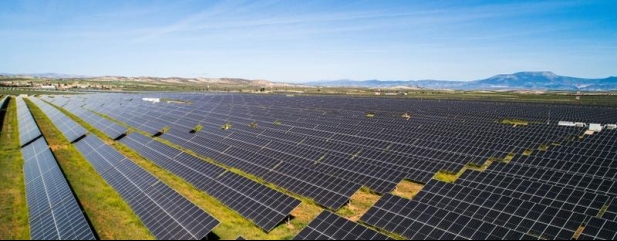Archived article
Please note that tax, investment, pension and ISA rules can change and the information and any views contained in this article may now be inaccurate.
Why Foresight Solar Fund is beginning to radiate optimism

Foresight Solar Fund (FSFL) 93.5p
Market cap: £533 million
Over 2023, infrastructure funds were among the worst performers in the investment trust universe as higher rates made assets like bonds and cash relatively more attractive. Caught up in the wider renewable infrastructure trusts de-rating was the Foresight Solar Fund (FSFL), a sustainability-focused vehicle invested in solar and battery storage assets in the UK and overseas.
Shares believes the turn in the rate cycle will bring a brighter future for the sector as gilt yields come down, leaving the high yields on offer looking more attractive to income-hungry investors.
Well positioned to capitalise on this shift, Foresight Solar’s shares have scope to re-rate from an 18.2% discount to NAV (net asset value) as debt falls and the FTSE 250 firm sells non-core assets at attractive prices. Based on its full year 2024 target dividend of 8p, Foresight Solar offers a bumper 8.6% yield and a share buyback programme of up to £50 million, supported by the robust cash flows generated from a highly contracted revenue base, should limit the downside from here.
SUNNIER OUTLOOK
Foresight Solar is invested in and manages approximately 1GW (gigawatt) of renewable energy infrastructure in the UK and internationally. Steered by Foresight Group’s Ross Driver, the fund’s objective is to provide investors with a sustainable, progressive quarterly dividend and capital growth through investment in a portfolio of ground-based solar farms and battery storage systems, predominantly located in the UK.
The core of the portfolio is represented by ROC (Renewable Obligation Certificate) subsidised operational UK solar PV projects, alongside UK battery storage assets, Australian solar PV and Spanish solar PV assets. The company argues its UK sites consistently outperform peers in converting solar irradiation into electricity thanks to its dedicated team’s consistent application of advanced techniques.
‘We’ve got a strong portfolio here in the UK, which is where we are centred,’ explains Driver. ‘But we’ve also got our investments in Spain and Australia, so there is that international diversification to the fund. When the sun doesn’t shine over here, we should have some balance and diversification through those other markets.’
PORTFOLIO POWER
‘We’ve got the biggest share buyback programme in the sector relative to the size of the fund, we’ve increased that to £50 million,’ adds Driver, who believes that the renewables sector as a whole will benefit from a re-rating ‘once we start to see some more certainty in rate cuts coming through and now that power prices are settling down’.
Merely generating income isn’t enough in the current environment, so Foresight Solar Fund is now pursuing a refreshed strategy with a greater emphasis on total returns, specifically boosting returns through development and construction activities and with non-core portfolio assets being earmarked for sale. ‘Our yield is about 9%, but we also want to deliver a further 1% to 2% in capital growth and we are driving that through the development pipeline we are looking at,’ enthuses Driver.
In a second quarter update (8 August), Foresight Solar published an NAV of 114.9p per share, a small 0.2p increase over the quarter as near and long-term power price forecasts in the UK trended up, although this impact was largely offset by below-budget irradiation and generation due to unplanned network outages and a small number of inverter issues.
Foresight Solar’s assets in Spain and Australia continued to perform poorly, again given poor weather and network outages, and overall production for the whole global portfolio was 7.1% below budget.
Yet despite this below-budget generation in the period, cash flow remained resilient, primarily due to Foresight Solar’s power price hedging strategy. Visibility is high too, with the proportion of contracted revenue for Foresight Solar’s global portfolio being 89% for 2024, 83% for 2025 and 63% for 2026.
At 65% of NAV, Stifel observes that Foresight Solar’s net leverage is a bit lower than some peers, although it ‘remains too high in our view given the costs of debt and volatility in power prices’. However, the trust will update the market on its disposal programme at the forthcoming first-half results (18 September), which may provide further clarity on debt reduction and share buybacks, while ongoing charges of 1.15% are reasonable for a specialist renewable energy trust.
Important information:
These articles are provided by Shares magazine which is published by AJ Bell Media, a part of AJ Bell. Shares is not written by AJ Bell.
Shares is provided for your general information and use and is not a personal recommendation to invest. It is not intended to be relied upon by you in making or not making any investment decisions. The investments referred to in these articles will not be suitable for all investors. If in doubt please seek appropriate independent financial advice.
Investors acting on the information in these articles do so at their own risk and AJ Bell Media and its staff do not accept liability for losses suffered by investors as a result of their investment decisions.
Issue contents
Editor's View
Great Ideas
Investment Trusts
News
- Why investors have dumped Dollar General stock
- Burberry exits FTSE 100 after 15 years but EasyJet looks to have dodged relegation
- Shares in maritime artificial intelligence company Windward are flying
- Gym Group raises outlook ahead of first-half results
- Investors bet on Rolls-Royce recovery after engine trouble sparks sharp sell-off
- US non-farm payrolls in the spotlight after Jackson Hole speech
- Oracle facing growth acceleration acid test
 magazine
magazine








